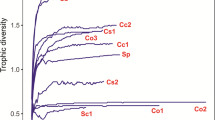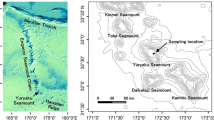Abstract
Stomachs from over 323 specimens of Hymenocephalus italicus, 168 Nezumia aequalis, 160 Coelorhynchus coelorhynchus and 1670 Trachyrhynchus trachyrhynchus were collected from September 1976 to September 1978 from the West Mediterranean continental slope at depths between 200 and 800 m. Copepods, amphipods and other pelagic crustanceans form the main fraction of the diet of H. italicus. The diets of N. aequalis and C. coelorhynchus consist largely of polychaetes, isopods, amphipods, mysids and decapod crustaceans. T. trachyrhynchus feed heavily on decapods. Decreasing fractions of small crustaceans are found in diets of all species as fish size increases. The mean size of prey increases with the body size of the fish. A positive size-depth correlation has been observed in macrourids. Juveniles and intermediates of N. aequalis, C. coelorhynchus and T. trachyrhynchus were found in shallow-water zones (<400 m), while adults were more common in deeper areas. Niche breadth and niche overlap were calculated between size groups. Niches are relatively broader with respect to habitat and narrower for prey size and prey type. The food overlaps between N. aequalis C. coelorhynchus and between C. coelorhynchus and T. trachyrhynchus are notably the greatest. Overlap in relation to habitat is high, while the correlation between niche parameters is very poor, indicating a certain degree of independence between these factors. Alpha matrices were estimated using both multiplicative (α product) and additive (α summation) multidimensional estimates for niche overlaps. Rates of competitive exclusion are low.
Similar content being viewed by others

Literature Cited
Brown, J.H. and G.A. Lieberman: Resource utilization and coexistence of seed-eating desert rodents in sand dune habitats. Ecology 54, 788–797 (1973)
Buchanan, J.B.: The biology of Calocaris macandreae (Crustacea: Thalassinidae). J. mar. biol. Ass. U.K. 43, 729–747 (1963)
Cody, M.L.: On the methods of resource division in grassland bird communities. Am. Nat. 102, 107–147 (1968)
—: Competition and the structure of bird communities, 317 pp. Princeton, N.J.: Princeton University Press 1974
Dayton, P.K. and R.R. Hessler: Role of biological disturbance in maintaining diversity in the deep sea. Deep-Sea Res. 19, 199–208 (1972)
Gascon, D. and W.C. Legget: Distribution, abundance and resource utilization of littoral zone fishes in response to a nutrient/production gradient in Lake Memphremagog. J. Fish. Res. Bd Can. 34, 1105–1117 (1977)
Grassle, J.F. and H.L. Sanders: Life histories and the role of disturbance. Deep-Sea Res. 20, 643–659 (1973)
Hanski, I.: Some comments on the measurement of niche metrics. Ecology 59, 166–174 (1978)
Helfman, G.S.: Patterns of communities structure in fishes: summary and overview. Envir. Biol. Fish (The Hague: W. Junk) 3, 129–148 (1978)
Hespenheide, H.A.: Prey characteristics and predator niche width. In: Ecology and evolution of communities, pp 158–180. Ed. by M.L. Cody and J.M. Diamond. Cambridge, Massachusetts: Belknap Press 1975
Jørgensen, C.B.: Biology of suspension feeding, 357 pp. Oxford: Pergamon Press 1966
Keast, A.: Food specializations and bioenergetic interrelations in the fish fauna of some small Ontario waterways. In: Marine food ohains, pp 377–411. Ed. by J.H. Steele. Edinburg: Oliver & Boyd 1970
—: Trophic and spatial interrelationships in the fish species of an Ontario temperate lake. Envir. Biol. Fish (The Hague: W. Junk) 3, 7–31 (1978a)
—: Feeding interrelations between age-groups of pumpkinseed (Lepomis gibbosus) and comparisons with bluegill (L. macrochirus). J. Fish. Res. Bd Can. 35, 12–27 (1978b)
Lagardere, J.P.: Recherches sur la distribution verticale et sur l'alimentation des crustacés decapodes benthiques de la pente continentale du Golfe de Gascogne. Analyse des groupements carcinologiques. Bull. Cent. Étud. Rech. scient. Biarritz 11, 367–440 (1977)
Levins, R.: Evolution in changing environments, 120 pp, Princeton, N.J.: Princeton University Press 1968
MacArthur, R.H. and R. Levins: The limiting of similarity of convergence and divergence of coexisting species. Am. Nat. 101, 377–385 (1967)
Macpherson, E.: Estudio sobre relaciones tróficas en peces bentónicos de la costa catalana, 369 pp. Tésis, Universidad de Barcelona 1977
Margalef, R.: Ecologia, 951 pp. Barcelona. Omega 1974
Marshall, N.B.: Systematic and biological studies of the macrourid fishes (Anacanthini: Teleostei). Deep-Sea Res. 12, 299–322 (1965)
— and D.W. Bourne: A photographic survey of the benthic fishes of the Red Sea and Gulf of Aden. Bull. Mus. comp. zool. Harv. 132, 223–244 (1964)
Mauchline, J. and L.R. Fisher: The biology of euphausids. Adv. mar. Biol. 7, 1–454 (1969)
May, R.M.: Some notes on estimating the competition matrix. Ecology 56, 737–741 (1975)
McLellan, T.: Feeding strategies of the macrourids. Deep-Sea Res. 24, 1019–1036 (1977)
Menzies, R.J.: On the food and feeding habits of abyssal organisms as exemplified by the Isopoda. Int. Revue ges. Hydrobiol. 47, 339–358 (1962)
Nilsson, N.A.: Seasonal fluctuation in the food segregation of trout, char and whitefish in 14 North Swedish lakes. Rep. Inst. Freshwat. Res. Drottningholm 41, 185–205 (1960)
—: Interactive segregation between fish species. In: The biological basis of freshwater fish production, pp 295–313. Ed. by S. Gerking. Edinburg: Blackwell Scientific Publications 1967
Nyberg, D.W.: Prey capture in the largemouth bass. Am. Midl. Nat. 96, 128–144 (1971)
Orians, G.H. and H. Horn: Overlap in foods and foraging of four species of blackbirds in the potholes of central Washington. Ecology 50, 930–938 (1969)
Pearcy, W.G. and J. Ambler: Food habits of deepsea macrourid fishes off the Oregon coast. Deep-Sea Res. 21, 745–759 (1974)
Pianka, E.R.: Niche relations of desert lizards. In: Ecology and evolution of communities, pp 292–314. Ed. by M.L. Cody and J.M. Diamond. Cambridge, Massachusetts: Belknap Press 1975
Pulliam, H.R. and F. Enders: The feeding ecology of five sympatric finch species. Ecology 52, 557–566 (1971)
Rosenzweig, M.L. and P.W. Sterner: Population ecology of desert rodent communities: body size and seed-husking as bases for heteromyid coexistence. Ecology 51, 217–224 (1970)
Ross, S.T.: Patterns of resource partitioning in searobins (Pisces: Triglidae). Copeia 1977 (3), 561–571 (1977)
Schoener, T.W.: The Anolis lizard of Bimini: resource partitioning in a complex fauna. Ecology 49, 704–726 (1968)
—: Resource partitioning in ecological communities. Science, N.Y. 185, 27–39 (1974)
Werner, E.E.: Species packing and niche complementarity in three sunfishes. Am. Nat. 111, 554–578 (1977)
— and H. Hall: Niche shifts in sunfishes: experimental evidence and significance. Science, N.Y. 191, 404–406 (1976)
Zaret, T.M. and A.S. Rand: Competition in tropical stream fishes: support for the competitive exclusion principle. Ecology 52, 336–342 (1971)
Author information
Authors and Affiliations
Additional information
Communicated by J. M. Pérès, Marseille
Rights and permissions
About this article
Cite this article
Macpherson, E. Ecological overlap between macrourids in the western mediterranean sea. Marine Biology 53, 149–159 (1979). https://doi.org/10.1007/BF00389186
Accepted:
Issue Date:
DOI: https://doi.org/10.1007/BF00389186



